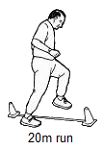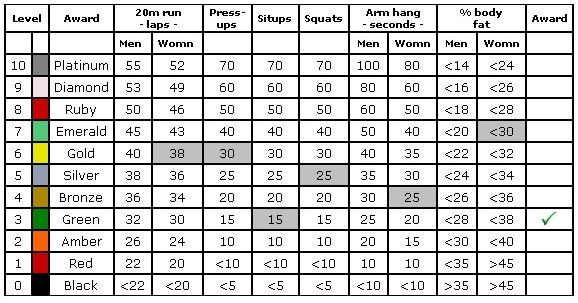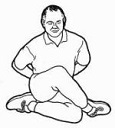|
|
||||||||||||||||||||||||||||||||||||||||||||||||||||||||||||||||||||||||||||||||||||||||||||||||||||||||||||||||||||||||||||||||||||||||||||||||||||||||||||||
| fitter - healthier - happier | ||||||||||||||||||||||||||||||||||||||||||||||||||||||||||||||||||||||||||||||||||||||||||||||||||||||||||||||||||||||||||||||||||||||||||||||||||||||||||||||
|
20m run test of aerobic fitness
Back in Alignment musculo-skeletal health program
Member of the Frontline Primary Health Care Network
|
The Universal Fitness Test was originally designed to help corporate organisations:
In most occupations, people need a minimum of aerobic fitness, strength and flexibility to do the job without breaking down, to do the job that normal fit and healthy people take in their stride. Even sitting on a chair all day requires a certain amount of fitness, without which, over the years and decades, people become dysfunctional and in pain.
The fitness focus of the Universal Fitness Test is aerobic fitness and strength - though it also includes two optional flexibility tests (hamstring and buttock) and a percent body fat test.
From the workplace the Universal Fitness Test has become just that, a universal test of physical fitness that is also appropriate to children, sporting teams and adults of all ages.
Any medical check up that doesn't also include and assessment of fitness is seriously deficient.
The good thing about it is that the tests are based on common fitness exercises. The more you practice them the better your performance in the test.
The 20m run test is the gold standard aerobic fitness test.
Administration
The
Universal Fitness Test is easy to administer. The
strength tests are the same tests as you'd use to improve your
strength at home. The
aerobic fitness test requires participants to see how many laps
of a 20m course they can complete in five minutes. It's an
adapted version of the 'beep' test, equally reliable and valid
but with a better distribution of scores - and easier to
administer. It's important you do
the tests in the order recommended. Do the 20m run test first,
then the situps and pressups, followed by the squats and arm
hang. If you do the squats before the situps you'll compromise
your situps' score. Percent body fat has also been included in
the list of assessments.
Universal Fitness Test Items
Universal Fitness Test Award
The award is based on the lowest points scored for a particular test item. For example if you're a woman and complete 38 20mrun laps, 30 pressups, 15 situps 25 squats and hang onto the bar for 30 seconds, the 15 situps count as the lowest score and you qualify for the 'green' award - see the shading and the tick in the right hand column of the scoring table below.
Highlight your best individual scores. To signify your Award, place a tick in the award box equal to the lowest score you achieved for the individual tests (as per the example below). Your award is based on the lowest score you achieve.
Strength tests taken until exhaustion - without stopping. 20m run -
laps in 5 minutes
SAMPLE AWARD - based on
lowest score 3
Point scoring system
You can also score points based on the level achieved for each test item.
Points received in the example above are:
SUPPLEMENTARY TESTS
Flexibility The third major fact of fitness is flexibility. Tight muscles move bones out of alignment. That’s the bad news. The good news is that once you have a flexibility training program muscles can move bones back into alignment again; poor function is restored to good. The body becomes pain free.
Whilst the flexibility tests don’t lend themselves to the Universal Fitness Test scoring system, we have included two supplementary tests of flexibility to round out the test battery.
Fit-for-work standards
The gold standard is readily achievable by anyone who has a regular aerobic fitness and strength training program.
A Miller Health project 7 Salvado Place, Stirling (Canberra) ACT 2611 Australia 61 2 6288 7703
|
|||||||||||||||||||||||||||||||||||||||||||||||||||||||||||||||||||||||||||||||||||||||||||||||||||||||||||||||||||||||||||||||||||||||||||||||||||||||||||||







